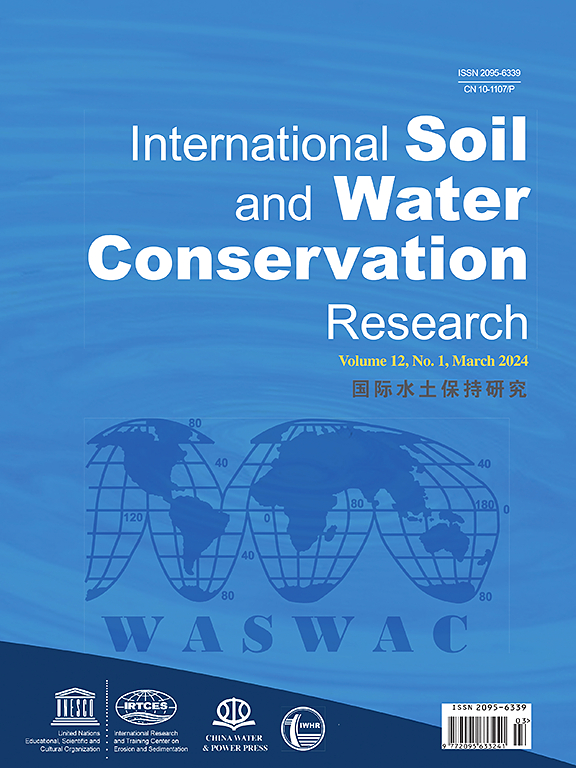Challenges and constraints of conservation agriculture adoption in smallholder farms in sub-Saharan Africa: A review
IF 7.3
1区 农林科学
Q1 ENVIRONMENTAL SCIENCES
International Soil and Water Conservation Research
Pub Date : 2024-03-20
DOI:10.1016/j.iswcr.2024.03.001
引用次数: 0
Abstract
Common farming practices in sub-Saharan Africa (SSA) such as intensive and repeated tillage, complete crop residue removal, and biomass burning create risks of soil degradation. To reduce these risks, conservation agriculture (CA) uses minimal soil disturbance, crop residue retention, and crop rotation in order to reduce soil erosion, improve soil quality and crop production, and facilitate climate change mitigation and adaptation. Nevertheless, CA adoption in SSA is extremely low. This paper aims to review current practices, challenges, and constraints to the adoption of CA in SSA. Our analyses show that CA is practiced in only about 1.25% of the total cultivated area in SSA, despite two decades of efforts to promote CA adoption among smallholder farmers. Specific difficulties in CA adoption by smallholder farmers in SSA may be attributed to i) lack of locally adaptable CA systems, particularly those integrating the needs of livestock production; ii) lack of adequate crop residues for surface mulch; iii) inconsistent and low crop yields; iv) lack of smallholder CA equipment for direct sowing; v) limited availability, high cost, and inadequate knowledge associated with the use of appropriate fertilizer and herbicides; and vi) lack of CA knowledge and training. Other problems relate to the management of specific soil orders, e.g., CA implementation on steeply sloping land and poorly drained soils such as Vertisols. CA adoption by smallholder farmers is also obstructed by socio-economic factors due to smallholder farmers’ focus on short term yield increases and their lack of access to markets, loans, and education. To facilitate wider adoption by smallholder farmers in SSA, CA approaches should be downscaled to fit the existing tillage tools and the specific agroecological and socio-economic farm settings.

撒哈拉以南非洲小农农场采用保护性农业的挑战和制约因素:综述
撒哈拉以南非洲地区(SSA)的常见耕作方式,如密集和重复耕作、完全清除作物残留物和焚烧生物质,都会造成土壤退化的风险。为了降低这些风险,保护性农业(CA)采用了尽量减少土壤扰动、保留作物残茬和轮作的方法,以减少土壤侵蚀、提高土壤质量和作物产量,并促进减缓和适应气候变化。然而,撒哈拉以南非洲地区对 CA 的采用率极低。本文旨在回顾撒哈拉以南非洲地区采用 CA 的当前实践、挑战和制约因素。我们的分析表明,尽管二十年来一直在努力促进小农户采用 CA,但在 SSA,CA 的种植面积仅占总种植面积的 1.25%。撒南非洲小农在采用 CA 方面遇到的具体困难可归因于:i) 缺乏适应当地情况的 CA 系统,特别是那些结合畜牧业生产需求的系统;ii) 缺乏足够的作物残茬用于地表覆盖;iii) 作物产量不稳定且较低;iv) 缺乏直接播种的小农 CA 设备;v) 与使用适当肥料和除草剂相关的可用性有限、成本高且知识不足;以及 vi) 缺乏 CA 知识和培训。其他问题与特定土壤的管理有关,例如在陡坡地和排水不良的土壤(如 Vertisols)上实施 CA。小农户采用 CA 还受到社会经济因素的阻碍,因为小农户注重短期增产,缺乏进入市场、获得贷款和接受教育的机会。为促进撒哈拉以南非洲地区的小农更广泛地采用 CA 方法,应缩小规模,以适应现有的耕作工具以及特定的农业生态和社会经济农场环境。
本文章由计算机程序翻译,如有差异,请以英文原文为准。
求助全文
约1分钟内获得全文
求助全文
来源期刊

International Soil and Water Conservation Research
Agricultural and Biological Sciences-Agronomy and Crop Science
CiteScore
12.00
自引率
3.10%
发文量
171
审稿时长
49 days
期刊介绍:
The International Soil and Water Conservation Research (ISWCR), the official journal of World Association of Soil and Water Conservation (WASWAC) http://www.waswac.org, is a multidisciplinary journal of soil and water conservation research, practice, policy, and perspectives. It aims to disseminate new knowledge and promote the practice of soil and water conservation.
The scope of International Soil and Water Conservation Research includes research, strategies, and technologies for prediction, prevention, and protection of soil and water resources. It deals with identification, characterization, and modeling; dynamic monitoring and evaluation; assessment and management of conservation practice and creation and implementation of quality standards.
Examples of appropriate topical areas include (but are not limited to):
• Conservation models, tools, and technologies
• Conservation agricultural
• Soil health resources, indicators, assessment, and management
• Land degradation
• Sustainable development
• Soil erosion and its control
• Soil erosion processes
• Water resources assessment and management
• Watershed management
• Soil erosion models
• Literature review on topics related soil and water conservation research
 求助内容:
求助内容: 应助结果提醒方式:
应助结果提醒方式:


